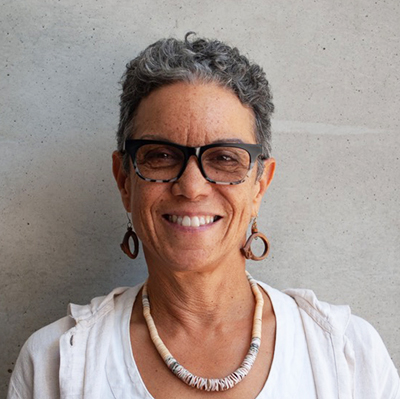Michaele Pride


Michaele Pride
Professor, Architecture
After years of visiting architecture schools as an accreditation examiner, Pride peers under the surface of a school to see its core. What does she look for in the soul of an architecture program? A balance of three elements: understanding the responsibility of the architect to the public, fostering achievement and creativity, and committing to a certain community.
Michaele Pride: Shifting the Conversation
By Cindy Graff Cohen
At The University of New Mexico’s School of Architecture and Planning, Professor Michaele Pride, Associate AIA, NOMA, is busy teaching, writing and directing the Design and Planning Assistance Center (DPAC). Yet beyond Albuquerque, Pride, who Design Intelligence named one of the 25 Most Admired Design Educators in the country, is seen as a leader in shifting the conversation about architecture and how people learn to be architects. In a career of many contributions to the field and to the places she has shaped, one of her most important achievements has been her key role as a national leader in rethinking the entire accreditation process for every school of architecture in the United States and Puerto Rico. In 2020, that conversation became codified, in a remarkable new set of standards for the National Architectural Accrediting Board (NAAB).
After years of visiting architecture schools as an accreditation examiner, Pride peers under the surface of a school to see its core. What does she look for in the soul of an architecture program? A balance of three elements: understanding the responsibility of the architect to the public, fostering achievement and creativity, and committing to a certain community.
“You’ll see schools that drift really far on one end of this triangle, like all they teach is the law, the technical aspects, the legal responsibilities; others dismiss or disregard that responsibility on behalf of creative expression, more like an art school,” she said. “More and more programs are committed to their communities. We have a responsibility to the public to be thoughtful about our work and its impact on all society and the way the built environment treats, supports and uplifts the human spirit.”
Accreditation: Tackling the Tough Questions
Pride’s interest in professional standards for architecture schools goes back to 2005, when she taught and served as the director of the University of Cincinnati School of Architecture and Interior Design. During that time, the school had its own accreditation team visit coming up – and she did not know what to expect. Across the board, these accreditation ordeals have been more than a little intimidating, requiring months of preparation for the visitors’ meticulous review of student work. To be better prepared, Pride volunteered on an accreditation team. She enjoyed what she learned so much that the one-time experience developed into an almost annual trip: she has visited a dozen of the 123 institutions offering NAAB accredited programs.
In 2018 when the time came to update the NAAB’s 2014 accreditation code, she became the ACSA (Association of Collegiate Schools of Architecture) representative on the Accreditation Review Forum steering committee. The “update” turned into a substantive re-think of what the profession needed of its practitioners – and how to best teach those skills and values.
Pride sees rigorous accreditation as absolutely essential and notes that in the eight years between team visits, each accredited program still files comprehensive annual reports. However, she and her colleagues also saw that the time was right for a fresh approach for NAAB, which celebrates its 80thyear of service to the profession this year. For two years, the committee’s 15 members met, brainstormed, and widened their constituencies, eventually bringing in over 100 participants for writing teams and specific study groups. Pride was on the writing group that finalized the new document.
“The new conditions are dramatically different,” Pride emphasized. “There's a shift to self-assessment and setting goals along with simplicity: we went from 26 student performance criteria to just 14 criteria.” Only two criteria require student work as evidence of meeting standards: traditionally accreditation examiners spent hours in closed-off rooms going over portfolios, projects, and papers. More conversation will take place with more interaction among faculty, students, and examiners.
Directing DPAC, at Last
Today, Pride is especially happy to begin her second year leading DPAC, a job she applied for 25 years ago and says she has worked toward ever since. Pride’s journey to run this Center started while she was in private practice after graduating with her Bachelor of Architecture degree from Arizona State University. She was working in L.A., not far from where she grew up in Granada Hills. After the city’s civil unrest in 1992, she helped found the Design Professionals’ COALITION, which offered architectural and planning assistance to the neglected communities of South L.A. The experience taught her the power of socially responsible architecture and community engagement in urban planning and she knew that is what she wanted to do with her life.
When she heard about an opening at DPAC, she applied immediately. It fit her interests and mission. “I didn’t hear anything so I called them,” she recalled with a laugh. She learned that she missed out because she didn’t have a graduate degree.
So, with the help of former SA+P dean, Geraldine Forbes Isais, who recruited her to teach architecture courses at Woodbury University, along with mentors in the architecture programs at University of Southern California, where she taught, and UCLA, where she served as diversity coordinator, Pride immediately began applying to graduate schools. However, before matriculating, she was recruited to be the inaugural director of the new Downtown Design Center in Lexington, Kentucky – a college-community collaborative similar to DPAC.
The next year, she took off to get that graduate degree she lacked, earning her Master of Architecture in Urban Design from Harvard University Graduate School of Design. She then returned to Lexington to spend seven years on the University of Kentucky College of Architecture faculty.
Today she enjoys being a colleague with former dean Forbes Isais, and now she looks forward to working with another person from her past: Robert Alexander González, the new dean. After González earned his undergraduate architecture degree from UT Austin, Pride, as the UCLA architecture school’s diversity coordinator, tried to recruit him to their graduate program. He chose MIT instead, but they kept in touch over the years.
This fall she is working with students on a number of DPAC projects, including a major development in Santa Fe, where she lives in a historic home. The project is in Midtown, a 64-acre area of mixed-use growth not constrained by the historical layers of other sections in the city. The project includes designing and implementing a community engagement process to inform the final development plan and the agreement between the city and the developers. “Just think,” Pride said, “how often do students get to influence a signature development in the middle of a city?”
And how often do architecture professors have the opportunity to shape how architecture students learn their craft, now and into the future?
For years to come, accredited architectural schools—and their students and faculty—will benefit from Pride’s insights into what makes a great academic program for training great architects.

